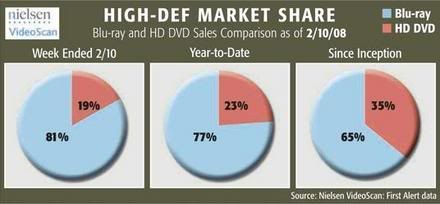Sony started two projects applying the new diodes:
UDO (Ultra Density Optical) and DVR Blue (together with
Pioneer), a format of rewritable discs which would eventually become Blu-ray (more specifically,
BD-RE).
[8] The core technologies of the formats are essentially similar. The first DVR Blue prototypes were unveiled at the
CEATEC exhibition in October 2000
[9]. In February 2002, the project was officially announced as
Blu-ray,
[10] and the
Blu-ray Disc Association was founded by the nine initial members.
The
DVD Forum (which was chaired by
Toshiba) was deeply split over whether to go with the more expensive blue lasers or not. Although today's Blu-ray Discs appear virtually identical to a standard DVD, when the Blu-ray Discs were initially developed they required a protective caddy to avoid mis-handling by the consumer. (Early CD-Rs also featured a protective caddy for the same purpose.) The Blu-ray prototype's caddy was both expensive and physically different from DVD, posing several problems.
[11] In March 2002, the forum voted to approve a proposal endorsed by
Warner Bros. and other
motion picture studios that involved compressing HD content onto dual-layer
DVD-9 discs.
[12][13] However, in spite of this decision, the DVD Forum's Steering Committee announced in April that it was pursuing its own blue-laser high-definition solution.
[14] In August, Toshiba and NEC announced their competing standard Advanced Optical Disc.
[15] It was finally adopted by the DVD forum and renamed to HD DVD the next year,
[16] after being voted down twice by Blu-ray Disc Association members, prompting the U.S. Department of Justice to make preliminary investigations into the situation
[17][18]. Three new members had to be invited and the voting rules changed before the vote finally passed.
[19][20]
fuente
 ¡Bienvenido a mundodvd! Regístrate ahora y accede a todos los contenidos de la web. El registro es totalmente gratuito y obtendrás muchas ventajas.
¡Bienvenido a mundodvd! Regístrate ahora y accede a todos los contenidos de la web. El registro es totalmente gratuito y obtendrás muchas ventajas.


 LinkBack URL
LinkBack URL About LinkBacks
About LinkBacks

 Citar
Citar






 :cabreo
:cabreo 




 Habrá que darle un digno final al HDDVD comprando todo lo que interese a precio de risa.
Habrá que darle un digno final al HDDVD comprando todo lo que interese a precio de risa.